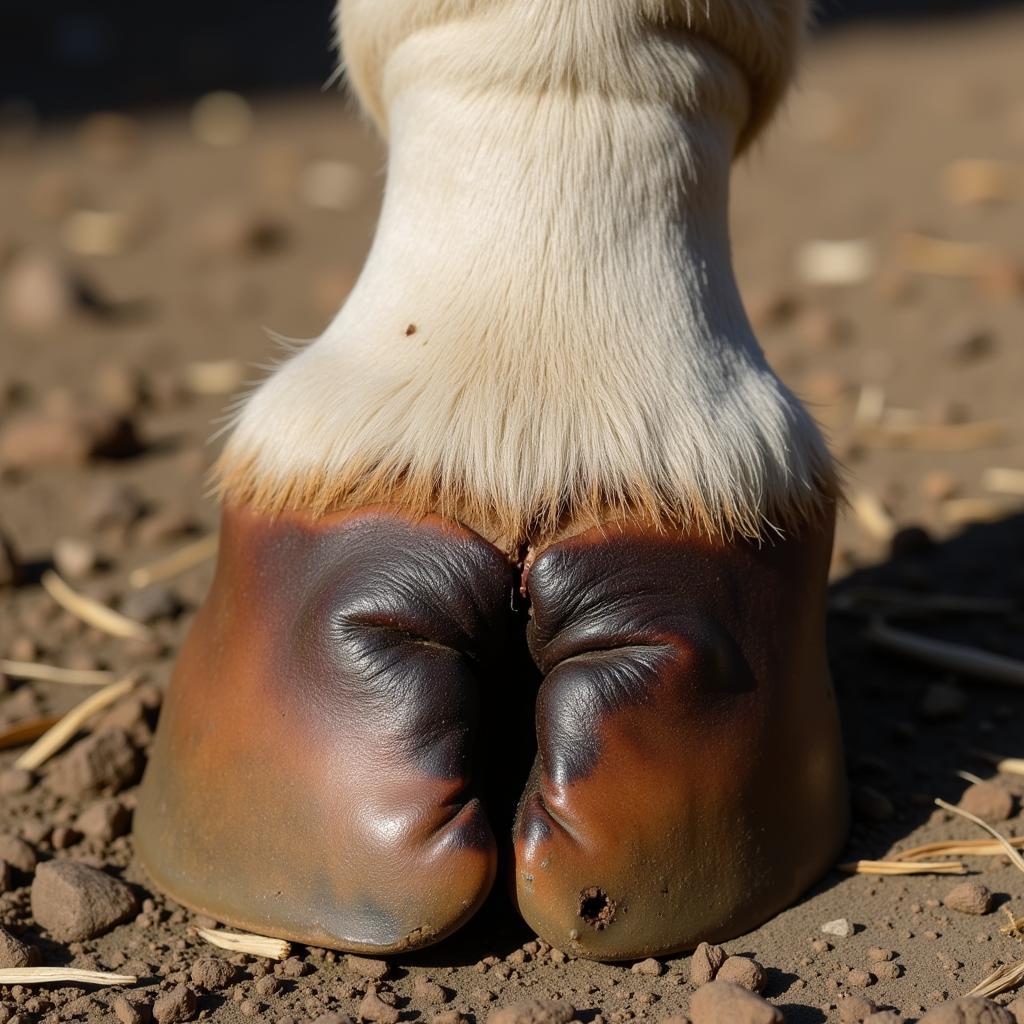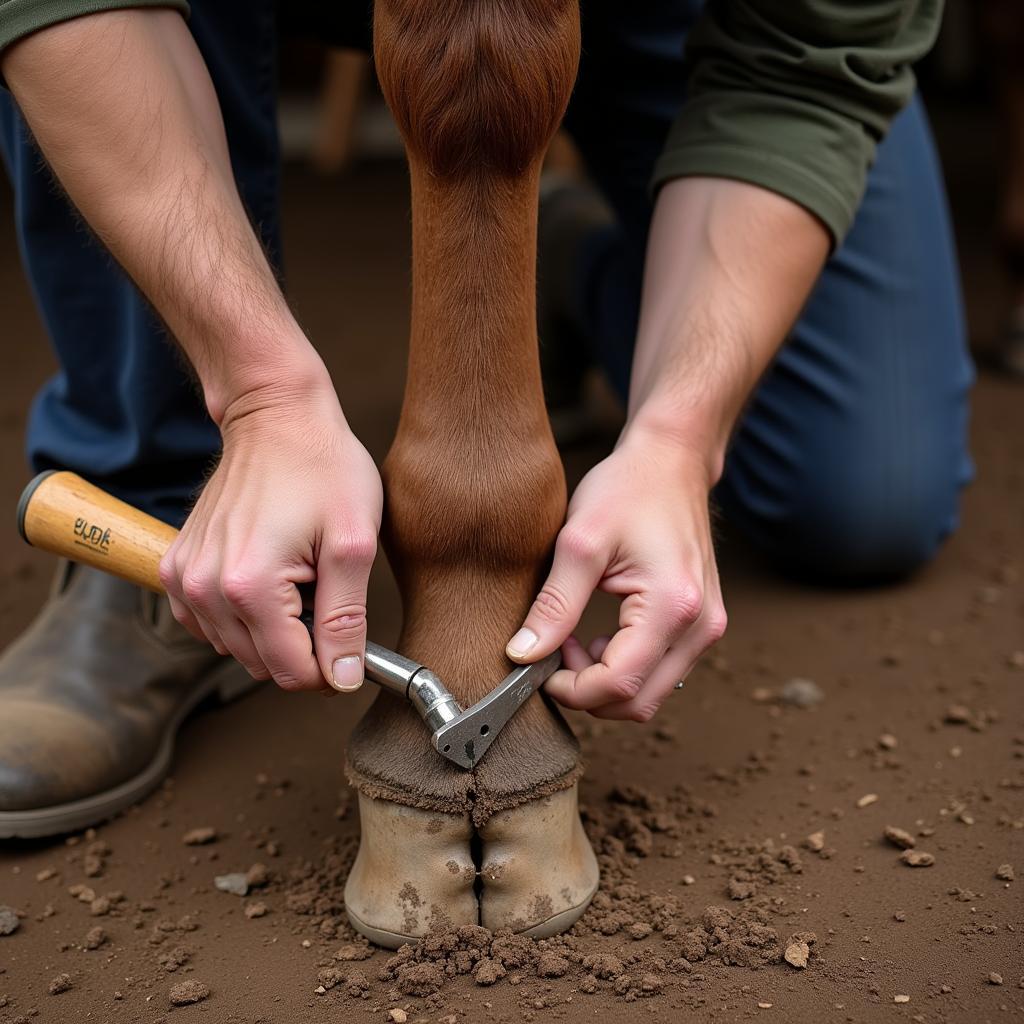Horse hoof health is crucial for a horse’s overall well-being. When your equine companion experiences hoof problems, it can impact their movement, comfort, and ability to perform. Understanding the common hoof health problems in horses, their causes, symptoms, and treatment options is vital for every horse owner. This guide aims to equip you with the knowledge to ensure your four-legged friend enjoys optimal hoof health.
Common Horse Hoof Health Problems
Horses can experience a range of hoof issues, some more common than others. Here are some of the most frequently encountered Horse Hoof Health Problems:
1. Abscesses
A hoof abscess is a painful condition resulting from a bacterial infection within the hoof. These infections typically occur following an injury to the hoof, such as a puncture wound or a crack that allows bacteria to enter.
Symptoms of a hoof abscess include:
- Severe lameness
- Increased digital pulse (felt in the artery at the back of the fetlock)
- Heat in the hoof
- Swelling around the coronary band (where the hoof meets the skin)
Treatment:
- Poulticing the hoof to draw out the infection
- Administering pain relief as prescribed by a veterinarian
- In some cases, your veterinarian may need to surgically drain the abscess.
 Horse Hoof Abscess
Horse Hoof Abscess
2. Thrush
Thrush is a bacterial infection that affects the frog of the hoof – the triangular-shaped structure on the underside. It thrives in damp, unsanitary conditions.
Signs of thrush:
- Black, foul-smelling discharge from the frog
- Softening and deterioration of the frog
- Lameness in severe cases
Treatment:
- Keeping the hooves clean and dry
- Applying topical thrush medications containing antiseptics or antifungals
3. Laminitis
Laminitis, also known as founder, is a serious condition that affects the laminae – the sensitive tissues that attach the hoof wall to the pedal bone (coffin bone) within the hoof. It can result from various factors, including:
- High carbohydrate intake
- Endotoxins released during illness
- Cushing’s disease
- Certain medications
Symptoms:
- Reluctance to move
- Heat in the hooves
- Increased digital pulse
- Pain in the toe region
- Characteristic “rocker” stance in chronic cases
Treatment:
- Identifying and addressing the underlying cause
- Providing pain relief
- Supportive measures like corrective shoeing and foot casts
- Dietary management
 Horse with Laminitis
Horse with Laminitis
4. White Line Disease
White line disease is a progressive hoof condition that involves the separation of the hoof wall from the underlying laminae. It’s caused by fungal or bacterial infections.
Signs:
- Hollow sound when tapping the hoof wall
- Cracks and separation along the white line (the junction between the sole and the hoof wall)
- Lameness
Treatment:
- Removing the infected hoof material
- Applying topical antifungal or antibacterial medications
- Corrective shoeing
5. Cracks
Hoof cracks can occur in different parts of the hoof wall and vary in severity.
- Causes:
- Trauma
- Improper shoeing
- Dry hoof conditions
- Nutritional deficiencies
Treatment:
- Minor cracks may require no intervention other than regular hoof care
- Deeper cracks may need stabilizing with special shoes or acrylic patches
Preventing Hoof Problems
Prevention is always better than cure when it comes to horse hoof health. Here are some essential hoof care practices:
- Regular hoof picking: Clean your horse’s hooves daily to remove dirt, debris, and manure.
- Regular farrier visits: Schedule trims every 6-8 weeks or as recommended by your farrier.
- Maintain a healthy diet: Provide a balanced diet and avoid overfeeding grain, especially high-starch grains.
- Provide adequate exercise: Regular exercise promotes good hoof circulation.
- Maintain dry living conditions: Ensure your horse’s stall is clean and well-bedded. Avoid muddy or wet areas.
 Horse Hoof Care
Horse Hoof Care
Recognizing When to Call the Vet
Early detection and intervention are crucial for effectively managing hoof health problems. Contact your veterinarian immediately if you observe any of the following:
- Sudden or severe lameness
- Heat in the hoof
- Swelling around the coronary band
- Discharge from the hoof
- Cracks in the hoof wall
Conclusion
By understanding the common horse hoof health problems, you can take proactive steps to prevent them and ensure your equine companion receives prompt veterinary attention when needed. Remember, a well-maintained hoof is a happy hoof!
FAQs About Horse Hoof Health Problems
Q1: How often should I pick my horse’s hooves?
Ideally, you should pick your horse’s hooves at least once a day. This helps remove dirt, rocks, and other debris that can accumulate and lead to problems like thrush or abscesses.
Q2: What is the best type of bedding for horses with hoof problems?
Horses with hoof problems benefit from bedding that is absorbent, dust-free, and comfortable. Good options include shredded paper, wood shavings, or rubber mats.
Q3: Can hoof supplements improve my horse’s hoof health?
Hoof supplements containing biotin, methionine, and zinc can help strengthen the hoof wall and promote healthy hoof growth. Consult with your veterinarian to determine if your horse would benefit from a hoof supplement.
Q4: How long does it take for a horse to recover from a hoof abscess?
Recovery time for a hoof abscess varies depending on the severity and location of the infection. It can take several weeks to months for the hoof to fully heal.
Q5: Is laminitis always fatal in horses?
While laminitis is a serious condition, it is not always fatal, especially if diagnosed and treated early. However, prompt veterinary attention is crucial for a positive outcome.
Need More Help with Your Horse’s Hoof Health?
If you have any further questions or concerns about your horse’s hoof health, please don’t hesitate to contact us. Our team at Justus Horses USA is here to assist you.
Phone: 0772127271
Email: [email protected]
Address: QGM2+WX2, Vị Trung, Vị Thuỷ, Hậu Giang, Việt Nam
We are available 24/7 to answer your questions and provide expert advice. Learn more about specific hoof care products, including hoof supplements for horses, on our website. We also have a horse 1st aid kit guide to help you address emergencies.